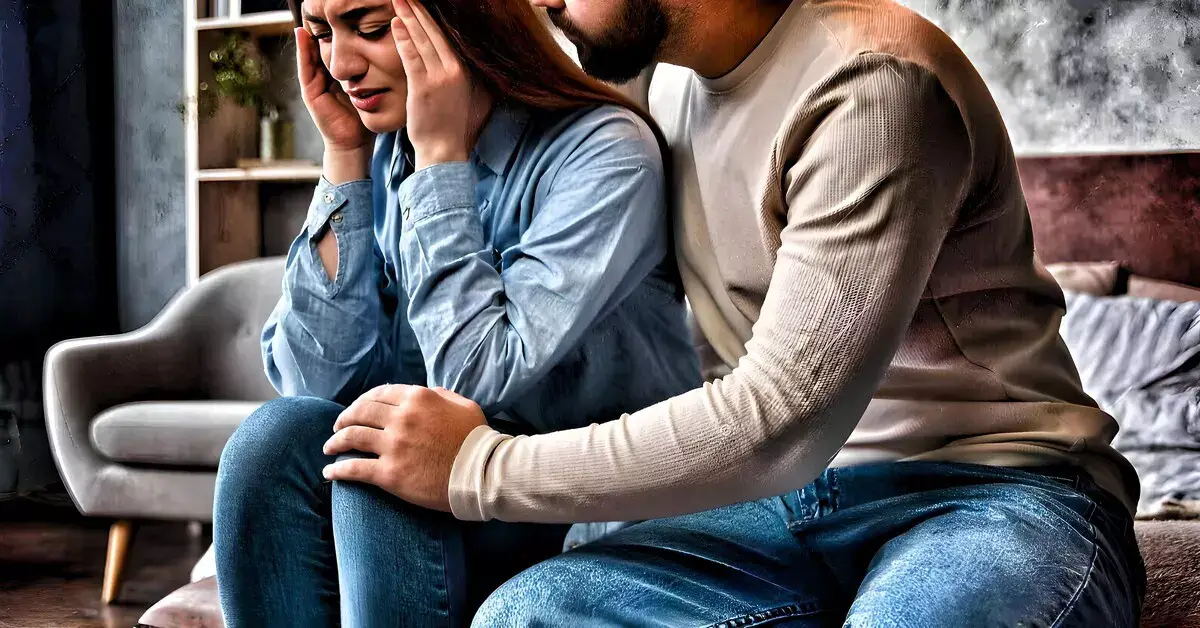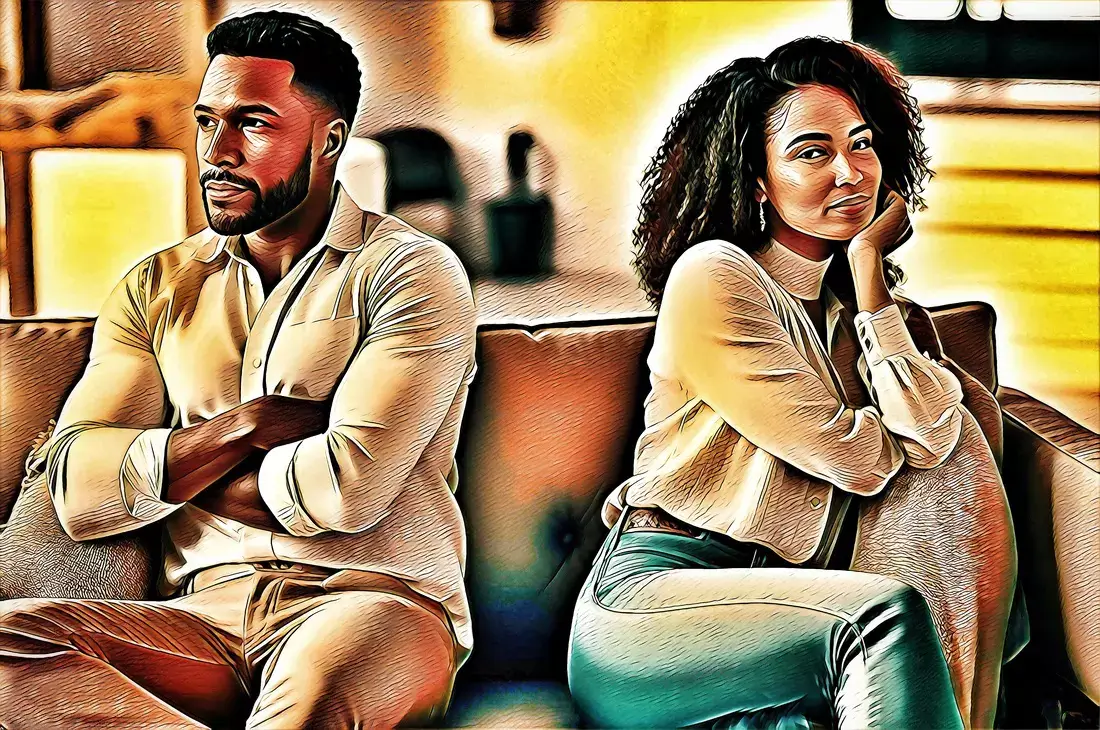16 dynamic ways to outline a couples therapy session to help you reconnect.
This blog post may contain affiliate links. If we find a product or service to be useful, we encourage you to visit the website via that link. If you make a purchase through our referral link, we may receive a commission. Rest assured, you will not be charged any additional fees. By using these links, you can support us while making your purchase. For more information visit here.
A few years ago, a woman said she pictured marriage like two astronauts floating around in space tethered together. This analogy of two people fumbling with ropes in zero gravity, trying to sync up, is a fitting way to describe a relationship.
To help with this process, couples therapy can be a worthwhile resource for strengthening relationships and providing ongoing support.
Most individuals who are in the process of isolation or divorce often overlook one thing, which is couples therapy. The couple must seek marriage counseling once during the separation process.
A couples therapy session can help you grow in your relationship by bringing attention to the issues you’ve been having. But couples are all unique, which is why one type of therapy won’t work for all couples.
There are many goals that a couple might have before entering therapy, but all relationship counseling sessions have some basic frameworks. Thus, it’ll be helpful for couples who attend therapy sessions to know what will happen there in advance.
This article will explore 16 ways a counselor can outline a couples therapy session and help them reconnect. Anyone can also start by reading the following blog!
How to reconnect with your partner in couples therapy sessions?
Couples therapy may be the answer if you feel disconnected from your partner. This article explores a typical couples therapy session and how it can help reconnect you with your partner.
Couples therapy sessions allow the counselor to help each spouse understand the other’s perspective and ultimately reconnect. In the sessions, a mentor looks at potential solutions to inside and outside problems causing conflict within their relationship.
What happens in a typical session?
In most cases, couples therapy involves sitting with a therapist and discussing your problems. The therapist will provide guidance and help you find solutions to these problems. Often, they will ask each person to complete individual homework assignments outside of the sessions to further advance the healing process.
Why does it work?
Therapy for couples works. It gives a safe space to talk freely and honestly. It also lets you see things from your partner’s view, which can help break down walls between you two. Finally, working on your relationship with a professional therapist gives you the best chance of success.

16 Ways a counselor outlines a couples therapy session.
Whether your marriage is suffering from a lack of jealousy or communication, there are ways to help your marriage get back on track. Couples counseling is all about the two people in the relationship. This is the reason many couples see a therapist or counselor together.
The first thing that a therapist will do is get both partners to talk about their pain. This is especially helpful for people who are in the early stages.
Here are 16 strategies a counselor may use in a couples therapy session to help you two reconnect in the relationship. Let’s discuss them one by one.
1. Identify the reasons for your unhappiness and what you want to achieve from therapy.
When a couple enters therapy, the counselor will spend some time investigating why they are seeking treatment. What are the specific issues that they are hoping to address? What are their goals for therapy?
After getting a sense of what the couple wants to achieve, the counselor will then explore the couple’s history and relationship.
This will help the counselor understand how the couple interacts and what may contribute to the current problems. After the counselor gets an idea of the couple’s relationship, they embark on fixing the problems that they want to solve.
This may involve exploring communication techniques, problem-solving strategies, and other tools to help the couple improve their relationship.
2. They ensure that one partner will not dominate the other’s discussions and needs.
Both partners must feel heard and have their needs met during couples therapy sessions. To ensure this is the case, counselors ensure that one partner is not overpowering the discussion.
This can happen for various reasons, but usually, it’s because one partner is more vocal than the other. It also occurs when one partner requires more counseling than the other.
If one partner dominates the discussion, the counselor will usually try to redirect the conversation to ensure both partners have time to speak. Sometimes, the counselor may even ask one partner to leave the room for a while so that the other can have some time to talk.
When couples go to therapy, experts do everything they can to make sure that both partners feel heard.
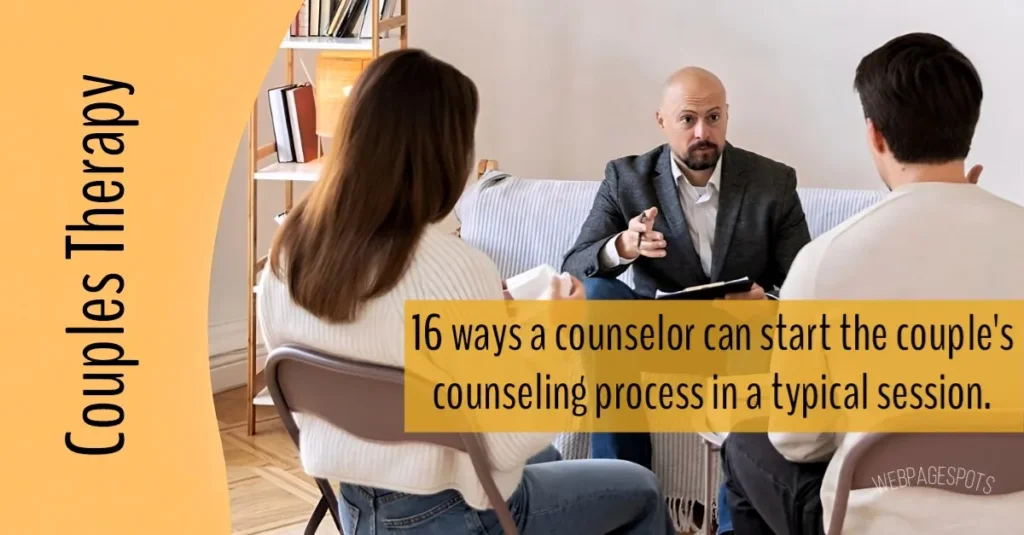
3. They outline what each person contributes to their relationship, strengths, and weaknesses.
Going to a couple’s home can be a great way for pairs to spot and fix habits that make their bond tough.
A counselor who guides couples employs a variety of strategies and techniques to help them fully understand each other. This lets them know how they each contribute to their partnership.
To maintain the relationship, both parties must understand what each other contributes. This means being aware of both strengths and weaknesses.
The counselor aims to help them see where they can improve their relationship. Knowing what each person contributes to the relationship can provide several benefits.
- Improved communication
- Increased empathy
- Greater understanding
- Deeper connection
- Increased intimacy
The “strengths and struggles” exercise is one method a couple’s therapist might employ. Each person in the couple takes turns identifying their own strengths and struggles within the relationship.
This can help each person identify the things they bring to the relationship that are positive and supportive.
In addition, it helps them pinpoint areas where their clients need to work on improving their behavior.
A couple’s therapist may also employ an approach known as “communication mapping.” This involves creating a visual representation of the couple’s communication patterns. There are both positive and negative interactions in these patterns.
This can help couples figure out what they’re good at communicating and helping each other with, as well as what they need to work on.
Finding habits that aren’t helpful is another way to do it. The therapist helps both people figure out what they do that hurts the relationship, like criticizing, being angry, or avoiding.
The therapist will then help the couple improve how they connect with each other.
To facilitate easier communication about feelings and thoughts, the therapist ensures the client feels safe and unjudged.
The goal of couples therapy is to help each partner understand what they bring to the relationship and how they can improve it. This will help the couple build a stronger, more caring relationship.
4. They clarify what each member expects of the other.
In couples therapy, the therapist will typically work with each couple member to clarify their expectations of each other. A counselor will use a variety of techniques to achieve this, including:
Reflective listening: By actively listening and repeating what the other person has heard, the therapist helps them express their expectations.
Collaborative goal-setting: The therapist can help the couple work together to set specific, achievable goals for their relationship, including expectations for how each partner will behave.
Communication skills training: The therapist can teach the couple communication skills, such as active listening, expressing needs and wants, and resolving conflicts constructively.
Emotional awareness and expression: A therapist helps each person in a pair understand and talk about their own feelings, as well as understand and react to their partner’s feelings.
These strategies will definitely allow the couple to articulate what they want from each other—in turn, through cooperation, they will have fun during the process.
During the process, it is crucial for the therapists to remain neutral and not take sides in the couples’ discussions, as they do.
In addition, the counselor helps the couple build their morale by highlighting their strengths and preventing future problems. They offer strategies for their clients to eliminate any future problems.
5. Identifying areas of conflict in the relationship.
Couples therapy sessions aim to help couples identify and resolve areas of conflict in their relationship. To do this, a counselor must identify the areas of conflict. They can do this through various methods, including observation, discussion, and questioning.
Having identified the conflicted areas, the counselor works with the couple to resolve them. This may involve providing guidance and education, facilitating communication, or helping the couple develop new skills.
The goal is to help the couple improve their relationship and build a stronger bond. Many couples therapy sessions include teaching the couple problem-solving and coping skills. These skills can help the couple better deal with conflicts when they arise.

6. Suggest ways to deal with conflict, better ways to argue, and calming techniques for when discussions get too heated.
Conflict is a natural part of any relationship. Whether it’s between two people or two countries, conflict is an unavoidable part of life. Yet, that doesn’t mean that conflict has to be negative.
In fact, conflicts are sometimes a positive force that motivates people to change and grow.
There are several strategies a counselor might suggest for dealing with conflict in a healthy and constructive way:
Communicate openly and honestly.
A counselor would better suggest to them, “Express your thoughts and feelings clearly and directly, and listen actively to the other person’s perspective. Avoid making assumptions or hastily drawing conclusions.”
Use “I” statements.
A counselor’s approach would be, “Instead of blaming or accusing, try to express how their behavior or words have affected you. For example, instead of saying, You always make me feel stupid, try saying, I feel hurt and frustrated when you speak to me that way.”
Practice active listening.
A counselor will suggest, “Pay attention to what the other person is saying and try to understand their perspective. Demonstrate your engagement in the conversation by using nonverbal cues such as nodding and maintaining eye contact.”
Taking a break.
If things get too heated, it’s helpful to take a break to cool down. If you take some time to think about it, you’ll be ready to talk again when things are more clear.
Use Time-Outs
A suggestion from the counselor will be, “If you’re getting too emotionally charged during an argument, you can use a time-out to take a break and calm down. This will help you avoid saying or doing something you might regret later.”
Practice forgiveness.
They will guide you to let go of grudges and forgive the other person for any hurtful words or actions—naturally, this’ll help you understand your partner better and make it less likely to happen again.
A counselor would like to help you learn effective ways to deal with and resolve differences—they teach calming techniques to help you manage your emotions during a conflict.
7. Dealing with a couple’s intimacy issues, whether they stem from job stress, feeling insecure, or something else.
Dealing with intimacy problems in a relationship can be quite intricate and have various aspects to consider. A counselor will address these issues with compassion, empathy, and a non-critical mindset.
A therapist can ask questions like:
- What are your emotions when your partner expresses a desire for intimacy?
- What do you think they’re thinking?
- Is there anything you want to say but don’t feel comfortable saying?
- Do you want your partner to do whatever they want with no attached feelings?
Couples therapy experts have many tips and tricks to help you overcome embarrassment, fear, or even awkwardness—you can freely talk about what’s going on in your relationship.
A counselor can help a couple deal with intimacy issues by taking the following steps:
Explore the underlying causes.
It is vital to identify the root causes of intimacy issues, which may be because of job stress, feeling insecure, or other underlying issues.
Encourage open and honest communication.
Encouraging open and honest communication between the couple can help them better understand each other’s needs, feelings, and concerns.
Help the couple set goals.
Setting goals can help them identify specific areas they would like to work on and provide a roadmap for making progress.
Provide education and resources.
A counselor may provide the couple with instruction and resources to address their intimacy issues, which may include information about intimacy and relationship building.
Encourage self-care
Both couple members need to prioritize their own troubles, as this can help them feel more connected and fulfilled.
They can refer couples to seek support from external sources.
The couple’s intimacy issues may significantly impact their relationship. They might find it beneficial for the couple to consider seeking additional support, such as individual therapy.
It is critical for a counselor to be patient, understanding, and work at a comfortable pace for the couple. It may take time for the couple to progress, so a counselor is always supportive and encouraging throughout the process.
8. Sees viable solutions to outside problems causing conflict within the couple’s relationship.
Outside problems are often the root cause of conflict within a relationship. Couples therapy sessions allow couples to air out their problems and explore workable solutions with the help of a professional counselor.
In couples therapy, counselors will look at any outside problems that may cause conflict between the couple.
These problems can include job stress, financial troubles, or disagreements about parenting. After identifying the core issue, they collaborate with the couple to discover a resolution that satisfies both parties.
Often, the solution to these outside problems will be to make some changes to how the couple communicates.
The counselor may teach the couple some new, essential skills to help them better express their needs and wants to each other. With these enhanced skills, the couple can resolve their outside problems and build a healthy relationship.
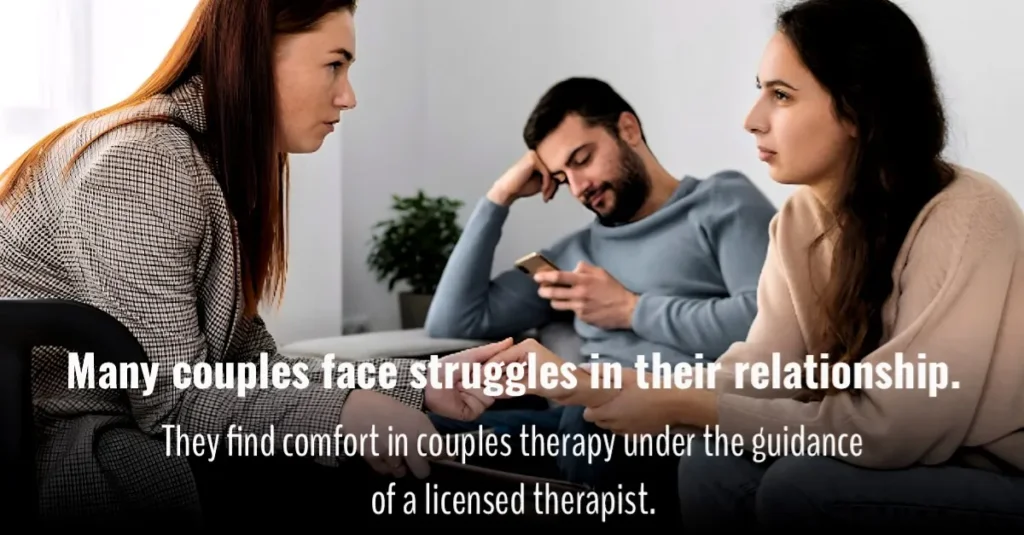
9. A counselor may discuss spending habits and ensure that each client feels heard about the issue.
In a couple’s therapy session, a counselor starts a conversation about spending habits if the couple is having money problems. The counselor gets to the root of the problem and determines what is causing the financial strain.
They may ask questions about both partners’ incomes, spending habits, and any debts or loans that may be affecting their finances. Once the counselors fully understand the situation, they offer solutions.
They can suggest creating a budget or cutting back on certain expenses. If financial problems are more severe, counselors may recommend couples therapy sessions focused specifically on budget management.
No matter what the cause of the financial strain is, it is paramount that both partners feel heard and understood.
The counselor creates a relaxed atmosphere where both partners can openly share their emotions and worries, and with a willingness to work together, couples finally overcome their financial obstacles.
10. A counselor helps clients through different options and scenarios in a couples therapy session.
A counselor can outline a couple’s therapy session with various techniques. In a couple’s therapy session, a counselor explains to the clients that “I am here to help you think through different options and scenarios.”
He is not there to tell them how they should behave to solve their problems.
There are many ways a counselor can help clients explore different options and scenarios in therapy. Some common techniques include:
The first step in any couples therapy session is for the counselor to establish rapport with both partners.
Reflective listening
In the previous section of this article, we discussed reflective listening—this helps couples better understand each other’s perspectives and feelings.
Assessing the problem or issues
The second step is for the counselor to assess the problem or issue that the couple is experiencing. This usually involves each partner taking turns sharing their perspective on the problem.
Identifying patterns
The therapist may assist couples in identifying patterns in their communication or behavior that cause conflict or relationship problems.
Third, role-playing
During the problem investigation, the therapist may ask couples to play different scenarios to practice new communication skills or ways of interacting, as well as brainstorm potential solutions.
Fourth, brainstorming
The therapist may ask couples to brainstorm solutions to their problems and help them evaluate the pros and cons of each option.
Fifth, provide education.
The therapist may provide education on topics related to relationships, such as communication skills, conflict resolution, or healthy ways to express emotions.
Sixth, offering guidance
Therapists can assist couples in working through challenges and changing their relationships for the better. A counselor will help the couple choose a solution they are both comfortable with that will work for them.
The therapist must tailor their approach to each couple’s unique needs and therapy goals, and finally, he follows up with the couple after they have implemented the chosen solution. This is to see how it’s progressing or if it needs any adjustments.
11. Help you discover commonalities in understanding your relationship.
Attending couples therapy may make you feel intimidated as you and your partner scrutinize your relationship and invite an unfamiliar individual to share their insights.
But despite all of this, couples therapy is a helpful way to improve your relationship. (I’m not promoting any third parties anywhere.)
In couples therapy, you and your partner sit with a counselor or team of counselors, and then they help you understand each other’s perspectives and discover commonalities in your understanding of the relationship.
Couples who attend therapy together can resolve conflicts more amicably and have a deeper understanding of one another. If you’re considering couples therapy, don’t be afraid to try it—maybe it will be the thing your relationship needs.

12. Further Help clients eliminate conflict in their relationship by looking at all practical solutions.
In a couples therapy session, a counselor encourages each partner to outline minor changes they can make to their daily routine. This will help them reconnect with their partner.
Modifying the way you communicate might be one option; spending additional time with each other is another; showing more love; and finding new ways to do so.
In addition, it can also mean appreciating all that one’s partner does by making small, meaningful gestures of kindness towards each other on a regular basis.
Even making minor changes in activities will help partners become closer while reducing any conflicts they may have between themselves.
It could be challenging at first, but eventually, through counseling from professionals, couples get back together again, having a much more affectionate and stronger bond than before!
Besides, helping your loved one feel valued through thoughtful acts of consideration can go a long way towards achieving that goal!
13. Asking you to create a schedule for how often you will try these activities. There will be little reward for this.
In a couples therapy session, a counselor will ask the couple to make a schedule of how often they will try to do prescribed activities together. Both parties will receive small rewards when they follow through with these activities.
This is a way to help them reconnect and eliminate conflict in their relationship.
The counselor may ask the couple to do at least one recreational activity each week—it can be something as simple as discussing a newspaper. The intention is to have something that you can do together with enjoyment.
Making a schedule may seem simple, but it’s difficult to stick to when life gets in the way. That’s why rewards are so valuable—they motivate us to keep trying, even when things are tough.
The reward for following through with the scheduled activities can be anything the couple agrees on—it’s something that makes both people happy.
The key to making this system work is communication—both partners need to be on board with the plan and check in with each other regularly to ensure it’s working well for them.
If someone feels like they’re not getting anything out of it, they ought to speak up and tell their partner.
Finding time for scheduled activities can be difficult, especially if the couple has young children or is juggling a job. But remember, even a brief time together can make a big difference.
14. Encouraging each partner’s self-awareness, understanding, and acceptance of differences.
In couples therapy, a counselor will encourage each partner to become more self-aware. This means they will help them better understand themselves and accept their differences.
This step is critical because it helps the relationship stay peaceful by making each person feel more understood and accepted by the other.
They will have to eventually master becoming more conscious of their thoughts, feelings, and actions, as this scope will include the reasons behind their responses in specific circumstances.
The counselor assists the pair in understanding their disparities—for many partners, this proves to be a daunting task, but it is crucial for the restoration of their union.
In addition, they should pick up the ability to value one another’s points of view and wants, even when disagreeing. Thus, with these tools, the twosome embark on a journey to fix their bond and establish a stronger tie.
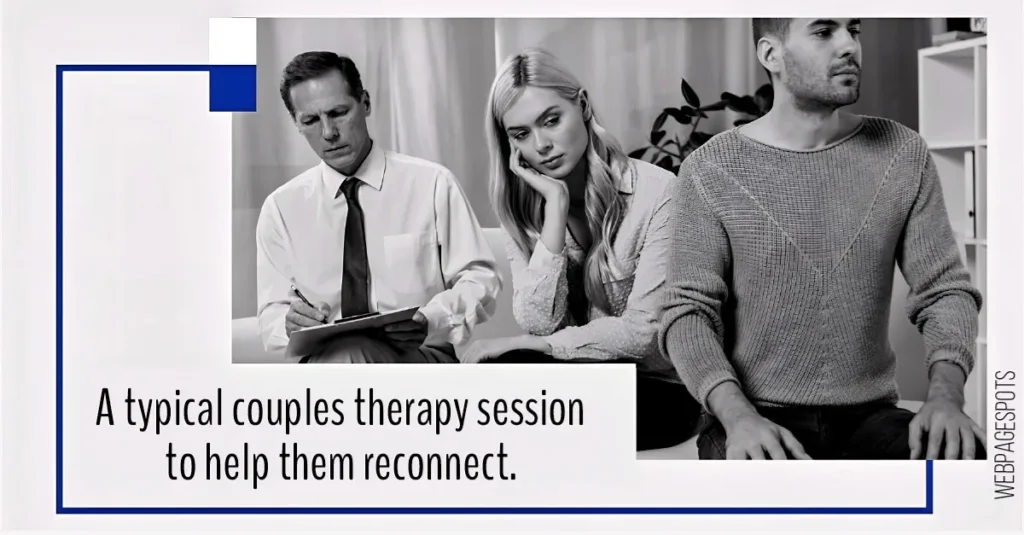
15. Motivating couples to enhance emotional intimacy and problem-solving skills.
In a couple’s therapy session, a counselor help motivate couples to reconnect by enhancing their emotional intimacy. A technique of doing this would be to facilitate and aid the couple in coming to terms with their emotions.
This will allow couple to express their feelings about how positive and negative experiences they have. This will also help the couple develop problem-solving approaches.
They will teach the couples how to come up with different techniques and then choose the best approach, forcing the couple to practice all these, so they can eventually do it by themselves.
16. Guidance through different techniques to encourage positive interactions and avoid negative reinforcement.
In a couple’s therapy session, a counselor may guide the couple through different techniques to encourage positive interactions and avoid negative reinforcement. A therapist may employ a technique known as “reframing.”
Reframing is when a person changes the way he thinks about a situation to see it in a more positive light.
Take the example of a couple who is arguing loudly about who should take out the trash. Someone who doesn’t want to take out the trash could reframe it as an opportunity for exercise.
Another technique is active listening, as described in the article above. A person who actively listens does so without interrupting or judging what the other person is saying. Restating what the other person said, asking questions, or paraphrasing can accomplish this.
Active listening can help improve communication by ensuring that both people feel heard and understood.
The next technique is “I statements,” as described in the previous section. These statements are when a person starts their sentence with “I feel” or “I need.” This helps to communicate needs and feelings in a non-blaming way.
Using ‘I statements’ can help to de-escalate arguments and make understanding each other’s needs easier.
These are just some techniques that a counselor may use in a couple’s therapy session. Counselors can help couples reconnect and improve their relationships by utilizing these techniques.
Conclusion
Therefore, it is crucial to help couple think about the opportunities for independent activities and create a plan that could help maintain a status quo separate from the therapy.
Treatments can be a rather easy and effective way to improve your relationships. Besides, positive interactions will help you feel more connected emotionally and satisfied.
Couples’ therapy allows monitoring the interaction between the partners, discovering the areas of disagreement, and finding the way to act to meet the needs of each person.
Partners gain more insight into one another through worksheets and Q&A.
Overall, couples therapy makes marriages happier and more fulfilling by helping both partners understand each other better.
But it is crucial to locate a counselor with whom you have a good rapport when contemplating couples therapy. Prior to getting involved in the session, inquire about their level of expertise and track record of assisting other couples.
As soon as you find a confident counselor, you can discuss various options and scenarios with them to facilitate a stronger relationship and reestablishment in the future.
Understanding the importance of copyright law is absolutely vital, as it strictly prohibits any reproduction or replication of works without the explicit permission of the author. Any unauthorized duplication of content will lead to legal action for copyright infringement under Section 14 of the Copyright Act.






